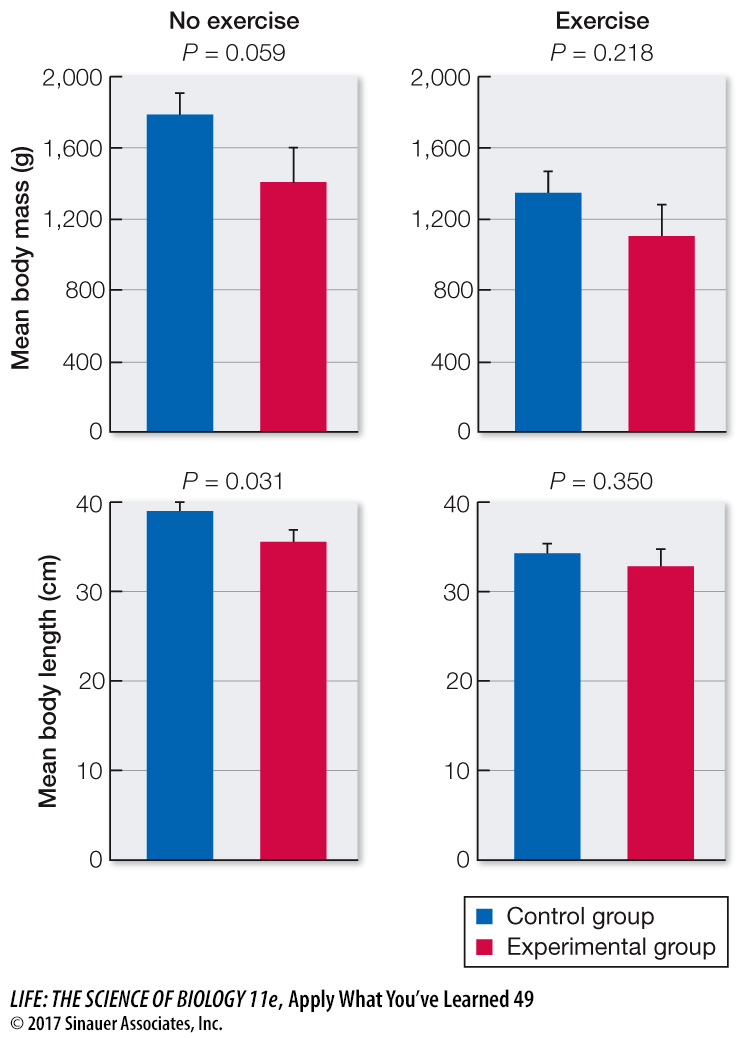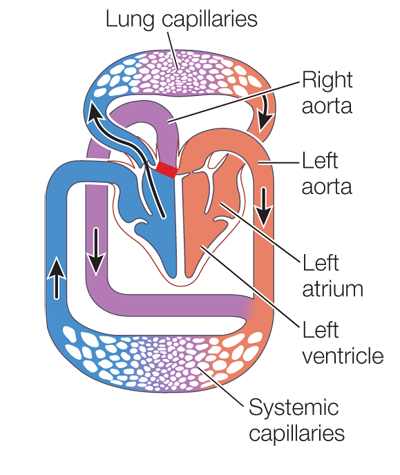Apply What You’ve Learned
1067
Review
49.2 Ectothermic reptiles have the ability to control blood flow to the pulmonary circuit, enabling them to conserve energy when they are not breathing.
Original Paper: Eme, J., J. Gwalthney, T. Owerkowicz, J. M. Blank and J. W. Hicks. 2010. Turning crocodilian hearts into bird hearts: Growth rates are similar for alligators with and without right-
Crocodilian hearts are four-
Working with young American alligators (5–
Data for each group were subjected to least squares analysis. Bars represent mean values determined for each group, and error bars are the standard errors of the means. The probabilities that the means in each comparison are due to chance alone are shown above the graphs.

Questions
Question 1
Create a diagram like that on p. 1048 showing the path of blood through a crocodilian heart. Mark the diagram to show the surgery done by the research group. On the diagram, show how the surgery changed the blood flow through the crocodilian heart. Write an explanation to accompany your figure. Then explain why the surgery made the crocodilian heart similar to a bird heart.

Blood from the right ventricle is blocked from exiting the right aorta by the surgery. Blood from the right ventricle can pass only through the pulmonary artery. This change converted the crocodilian heart into a heart similar to that of a bird, because a bird heart obligates the blood to go from the right ventricle to the lungs with no opportunity for bypass. In a bird, blood goes from the right ventricle to the lungs to the left atrium to the left ventricle to the body and then back to the right atrium and right ventricle again. In a crocodilian, the blood can go from the right ventricle to either the lungs or the body.
Question 2
For an alligator, what advantage is gained by being able to shunt blood away from the lungs?
When an alligator is diving and spending time underwater, it is not actively breathing. In these instances (which can extend for long periods of time), the animal does not need to expend energy to pump blood through the lungs. An adaptive advantage is the ability to conserve energy by not pumping blood to the lungs when there is no benefit to be gained from doing so.
Question 3
What do the data regarding body mass and body length suggest about the effects of blocking blood flowing from the right ventricle to the body? Does this provide evidence in support of the adaptive advantage of having a pulmonary bypass shunt? Explain your answer.
If bypassing the pulmonary circuit conserves energy in these animals, an indication might be that growth rates of control animals would have been higher than those of experimental animals, since control animals would have more energy available to divert to growth. However, if we require a P value < 0.01 to conclude that there is a significant difference between the control and experimental groups for both sedentary and exercised animals, there are no significant differences in body mass or body length. This indicates that growth rates between control and experimental animals were similar, suggesting that the pulmonary bypass capability confers no adaptive advantage in terms of growth of juvenile alligators, even when they are stressed by exercise. Therefore these data alone do not allow us to say that the shunt affords a significant conservation of energy related to growth.
Question 4
The animals in this study were maintained in captivity and supplied with food. How might these conditions limit the potential of the experiment to show an adaptive advantage of the aortic shunt?
An investigator could compare the duration of breath-
A second indicator could be the amount of food consumed and waste produced by experimental and control animals under otherwise identical conditions. This indicator could be used to compute calories burned and would support the hypothesis if experimental animals burned more calories than control animals, since experimental animals would need more energy to go about their daily activities.
A third indicator would be the number of eggs produced by female alligators in experimental and control groups. To support the hypothesis, the results from this study would have to show that experimental females produce fewer eggs over a defined time period than control females. The quantity of eggs is related to the amount of energy the animals have available to put toward reproduction, and loss of the shunt may cause experimental animals to have less energy to expend in producing eggs.
Go to LaunchPad for the eBook, LearningCurve, animations, activities, flashcards, and additional resources and assignments.